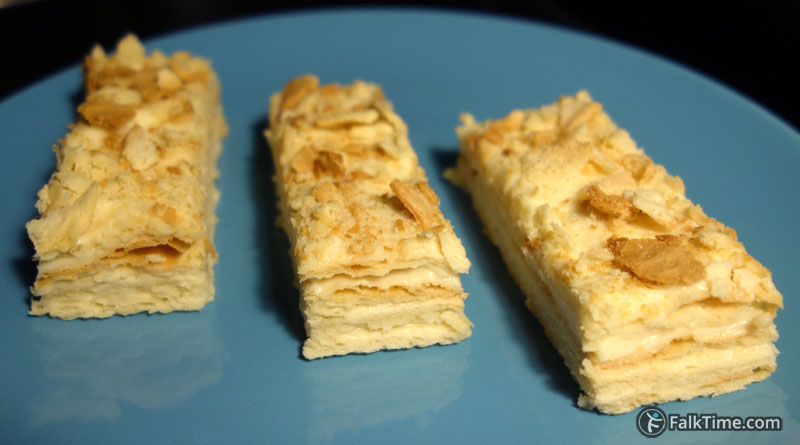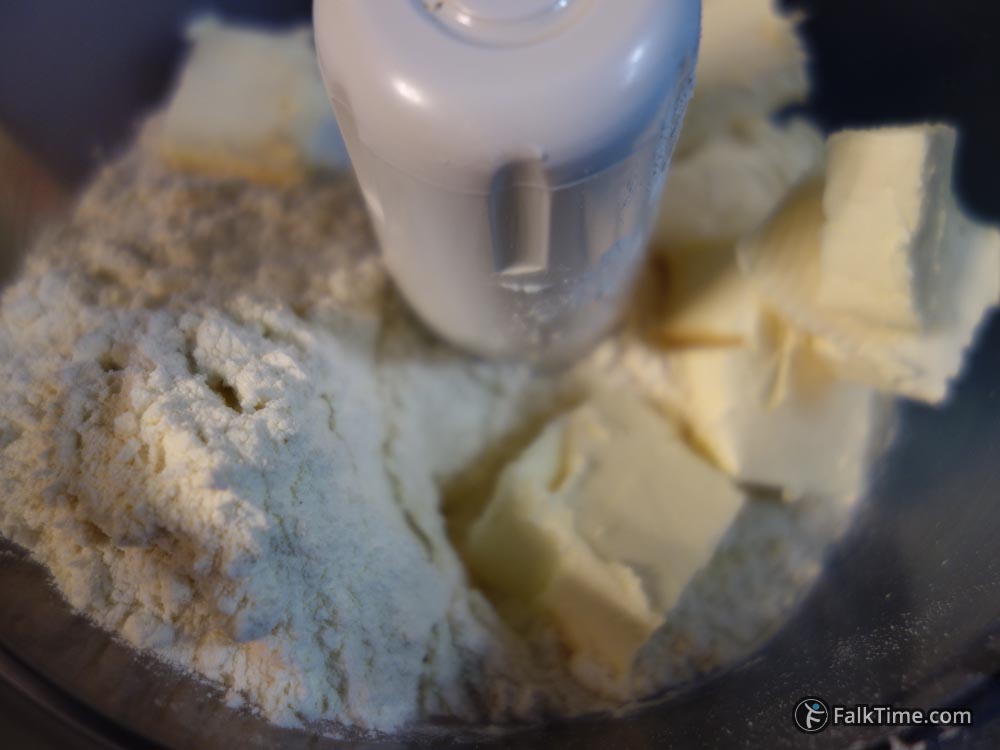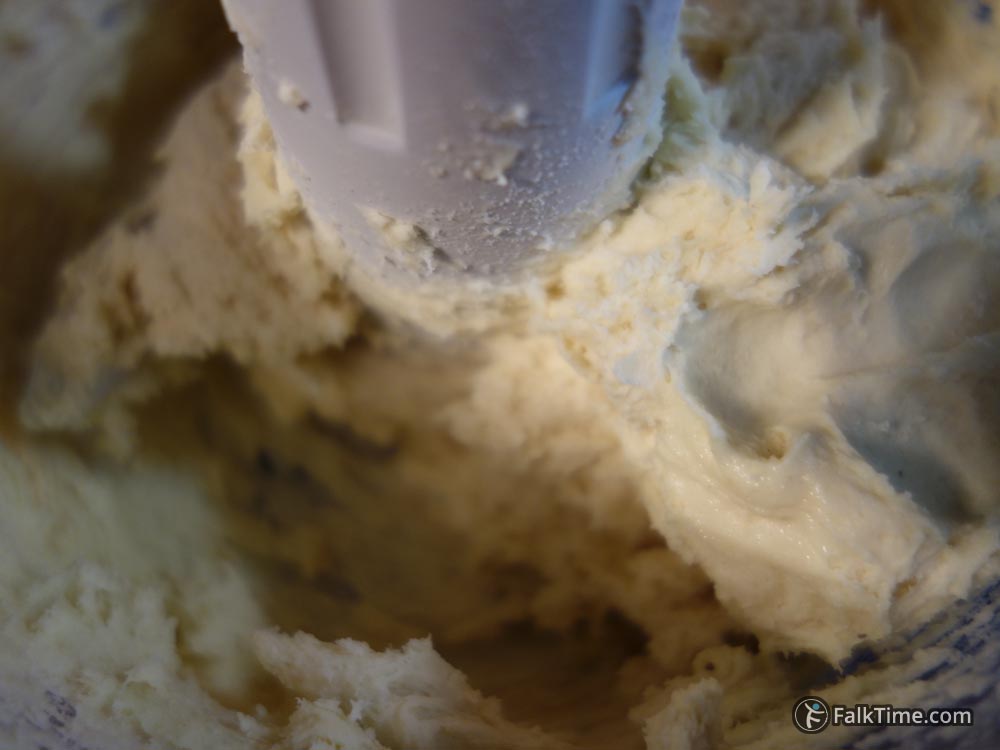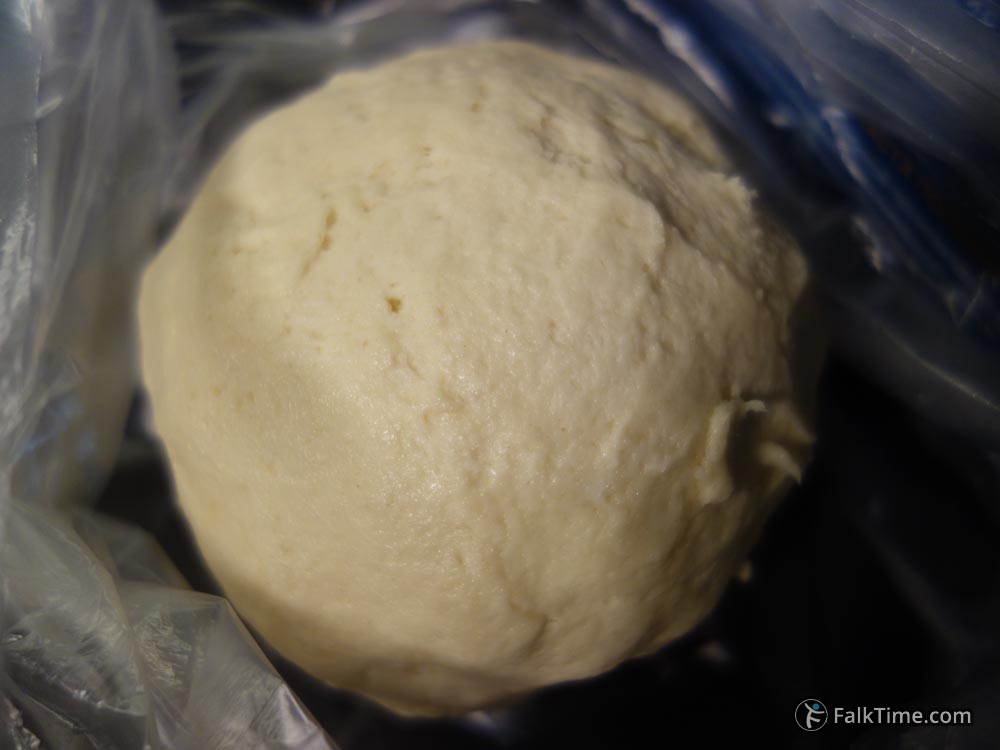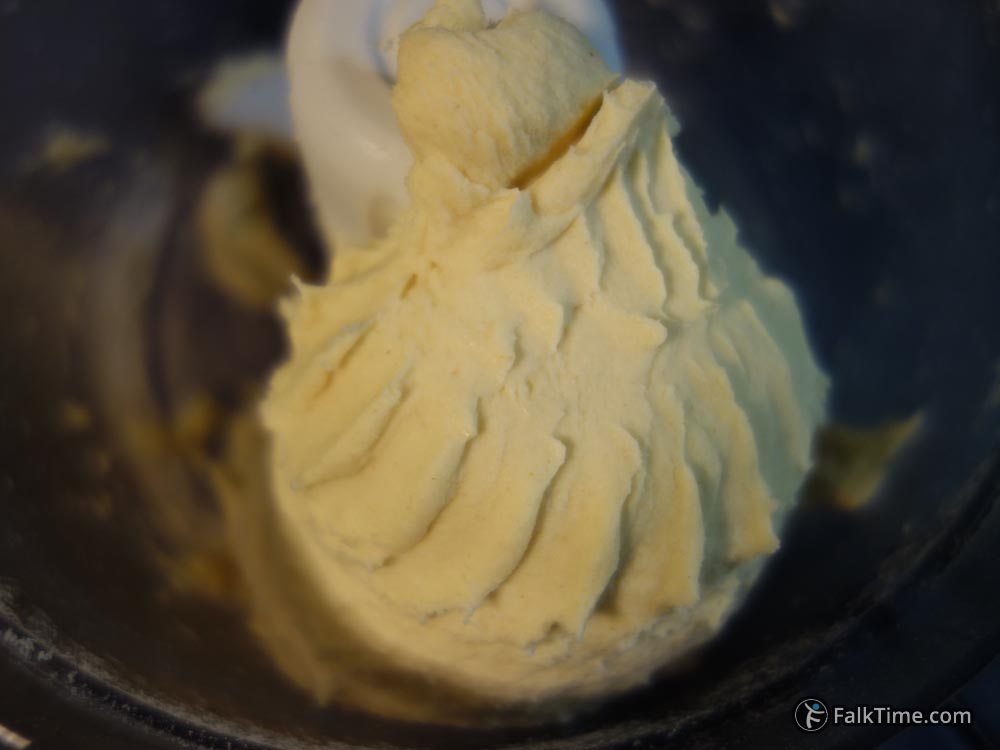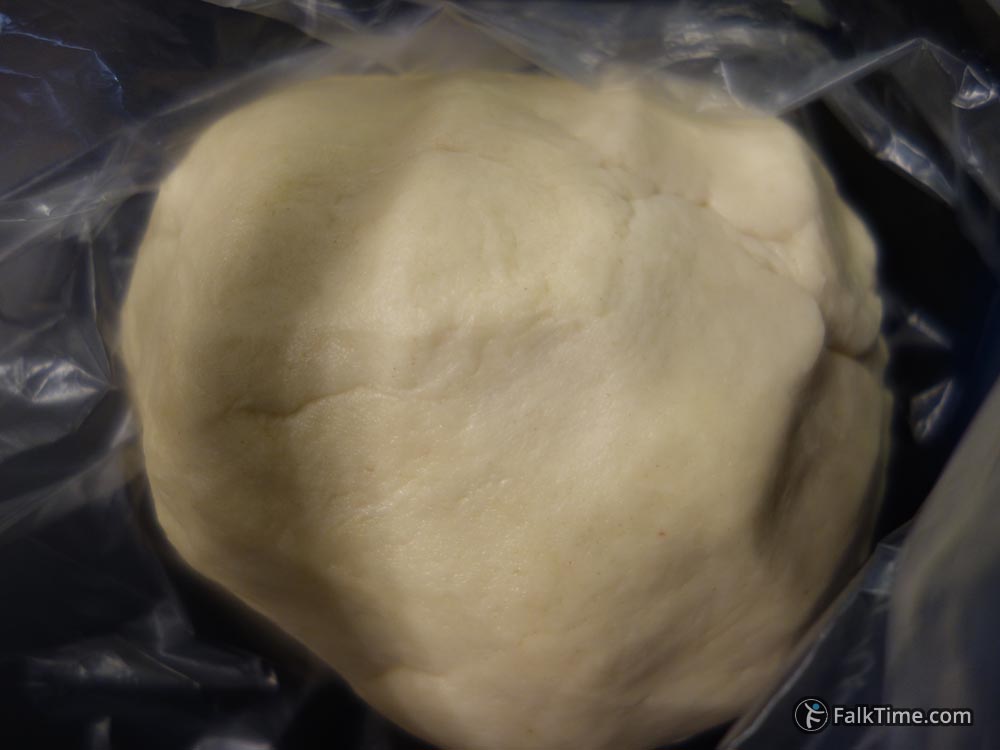Napoleon – popular Russian homemade cake
«Napoleon» seems to be one of the most popular homemade cakes in Russia. It is a cake with many thin layers made of puff pastry (like mille-feuille) or shortcrust pastry dough. Homemade Napoleon cake is traditionally made of shortcrust pastry dough, it is thinly rolled out, so it slightly reminds puff pastry dough.
Also there’s a big variety of fillings – the most popular are custard, buttercream and sweet condensed milk. Napoleon cake requires 1 day of rest before serving. So due to difference between fillings there can be different versions of cake:
- «Wet» Napoleon requires very thin layers of dough and the filling for this variety is custard. After 1 day crispy layers become soft, almost pancake-like.
- If you use custard but you make dough layers not that thin, you will get a medium-version of Napoleon: layers will remain a little bit crispy and dry after 1 day. But after 2 days this cake will become as soft as «wet» Napoleon. So the result is unstable.
- «Dry» Napoleon has usually buttercream filling. Buttercream can’t soften layers as much as custard.
In 1920s-1930s recipe of Napoleon cake was modified to make it cheaper. Butter was replaced with artificial one and skillful housewives could make custard almost out of nothing (with no eggs and flour instead of corn starch). We have now much better times in Russia, however many people still use recipes of their grandmothers that tried to save every penny. I will give you recipes that contain “right” and high-quality ingredients.
As you know, if the recipe was published on my website, it means that this is a simple one recipe. I will publish all varieties of Napoleon cake that will suit my taste. You just need to choose 1 dough and 1 filling for your Napoleon cake. The amount of dough (~650 g) is supposed to be rolled out to make 3 layers (size of 1 layer = size of backing sheet, 38×34 cm). If it is hot weather in your place, turn on the air-conditioner.
Dough:
- 200 g of cold butter (keep it in a fridge until you will need it)
- 350 g of all-purpose flour
- 100 g of cold water
- 2 tsp of vinegar
- 1 egg or 20 ml of cold water (layers made of egg dough are a bit softer, while without egg there are a bit crispier)
- (optional) 2 tsp of cognac, or ~0,7 ml of rum or cognac flavoring
Custard filling (~1,5 l):
- 1 l of milk (2,5-4% of fat)
- 8 egg yolks (can be replaced with 4 eggs of medium size, custard with eggs will have insignificant egg flavour but it won’t harm Napoleon cake)
- 200 g of sugar (when custard will be boiling, taste it – you still have an opportunity to make it sweeter, remember: dough layers are not sweet, so if custard tastes ok, then it means that it’s better to add more sugar)
- 70 g of corn starch (can be replaced with 80 g of wheat flour, it won’t harm Napoleon cake’s taste but egg yolk+starch custard and egg+flour custard have different tastes)
- 5 tsp of vanilla sugar (can be replaced with ~0,25 tsp of vanillin + 4,75 tsp of sugar – as for me it won’t harm your Napoleon cake at all)
- 200 g of butter (stir it to a cold custard)
Condensed milk filling (it will be very sweet cake):
- ~600 g of sweet condensed milk.
Buttercream filling (approximate amount of ingredients, I will correct it after some more experiments):
- 200 g of butter
- 380 g of sweet condensed milk
- (optional) my friends, Marina and Nikolay, add some liquid jam to their Napoleon cake with buttercream filling. Jam should be made of sour berries or fruit (f.e. gooseberry or cranberry) to have a brighter taste. 4-6 tbsp of jam are spread over one of cake layers in the middle. I like this idea because it makes Napoleon cake taste different.
Also you can visit buttercream section for your inspiration. There are interesting varieties of buttercream with fresh/frozen berries (f.e. strawberry buttercream) that can be used for unusual Napoleon cake.
Equipment:
- Dough: requires a food processor, otherwise you will spend a lot of time and labour.
- Dough: smooth rolling pin – dough layer should be of one thickness in all its zones.
- Dough: high quality parchment paper.
- Custard: hand blender (shaft with blades & shaft with whisk).
- Custard: spatula with flat end, so you can easily scoop the bottom of your pan while cooking.
- Custard: non-stick pan – otherwise custard will stick and burn. Some say that steel casserole is ok – my IKEA stainless steel casserole has spoiled all my custard. So it’s better to use any non-stick frying pan with small and thick bottom, and if all ingredients don’t fit in it, just divide cooking in 2-3 times.
If you have never tried Napoleon cake and you are not sure that you will like it’s taste – divide all ingredients in 3 and make a mini-cake (see the pic with divided layer on a baking sheet below).
Instructions
1. The dough: put flour in food processor. Put all liquid ingredients in 1 glass. Take butter out of the fridge, quickly cut it in big cubes (to fit food processor’s bowl) and switch on food processor.
2. Add liquid ingredients and quickly kneed the dough (~1 min). Shape the dough to a ball, put it in a plastic bag and put it in a fridge for 1,5 hours. If you would like to leave the dough in a fridge until tomorrow – there’s no problem. The dough can be easily stored in a fridge for 24 hours.
If you don’t have food processor, old method supposes that you put all flour on a cutting board, then you should dice the butter and top flour with it. Now you should cut and cut butter in flour (not forgetting to bring back flour to middle when it tries to escape) unless it becomes as small as the crumbs on the picture in step 1. When you’re done with it – add liquid ingredients and knead the dough manually (the sooner the better, because butter will melt in your warm hands).
The other manual method is to freeze butter and grate it. Then combine flour with grated flour. The rest of butter that is too small to be grated should be cut as I explained in previous method.
3. While the dough rests in a fridge, prepare filling for Napoleon cake at your choice: custard filling, classic buttercream or any other variety of buttercream.
4. While the oven is preheating up to 220°C in convection mode, cut 2 sheets of parchment (size = size of backing sheet+its walls). Make folds on a sheet of parchment to prevent its rolling back.
Take 1/3 of dough (the rest put back in a fridge). Quickly roll it out to make a layer that covers the entire sheet. It’s important to achieve equal thickness of layer. If the dough begins to stick to a rolling pin in the middle of process, sprinkle some flour over the dough. Also you may carefully hold parchment with one hand while rolling pin with the other.
5. Cut the layer with plastic knife. Traditionally Napoleon cake consists of 6-12 dough layers. Usually I choose square or rectangular shape, ‘cause it’s easier. If you would like to have a round Napoleon cake – then take a plate and cut the dough around it. In this case you need to roll the layer only to fit your plate (use 1/6 of dough or less, depending on the size of a plate).
Offcuts are used for decoration, so bake them together with layers. It’s important to pierce dough layer with a fork – the more holes the flatter will stay the layer.
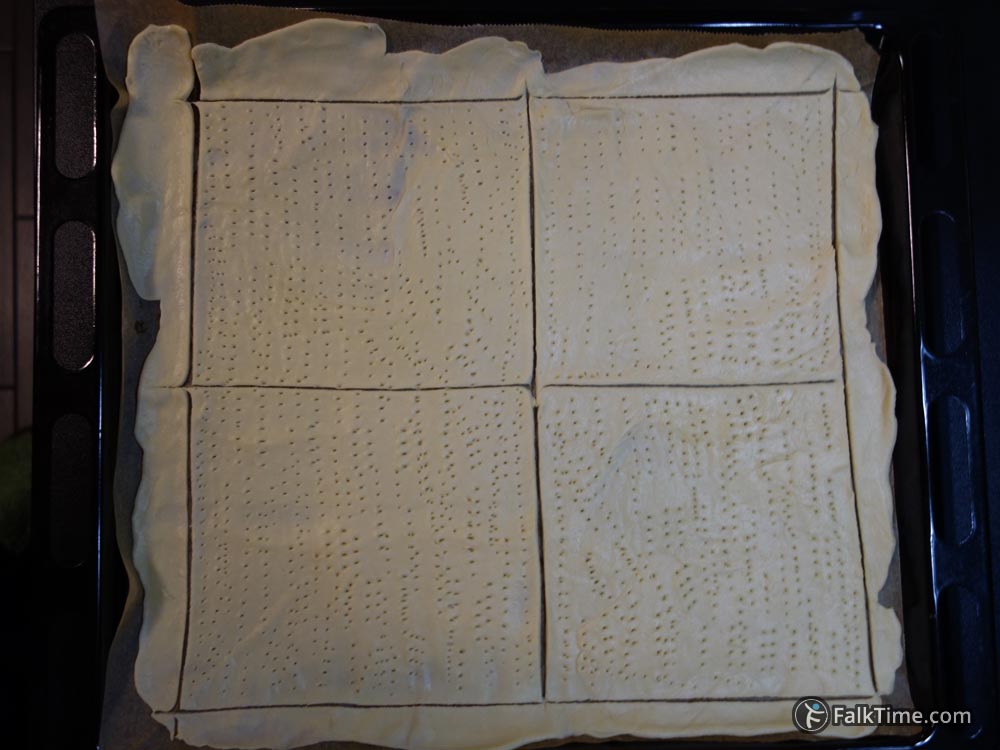
6. When the 1st layer is ready – put it in the middle of your oven. And set the timer for 4-5 min. After this time will pass you should be attentively watching after the layer, it requires only 5-8 min. baking. Note: brown colour for this type of pastry means that it is spoiled (it has bitter burned taste). You should take the layer out as soon as some areas become light-brown.
If you succeed to roll out the next layer in 4-5 min., then do it. If you need more time, then roll’n’bake 1 by 1.

Take ready layer out of the oven and transfer it together with parchment paper from the baking sheet. Put the next layer (the 2d piece of parchment paper) on a baking sheet and place it in your oven. Set timer to 4-5 min.
While the 2d layer is in an oven, carefully transfer the 1st one + offcuts from the parchment paper (I use long spatula). You’d rather put it on a flat heatproof surface to prevent layers from breaking. It’s possible to put ready layers one on one. The parchment paper left from the 1st layer will be used for 3d layer. Repeat steps 4-6 until you’re done with dough.
7. Inspect your dough layers – if there are brown areas, taste them. If they taste burned, replace them with good offcuts. Even if a layer broke down – you can use it. Just put it in the middle of cake and no one will notice it. Layers should cool down.
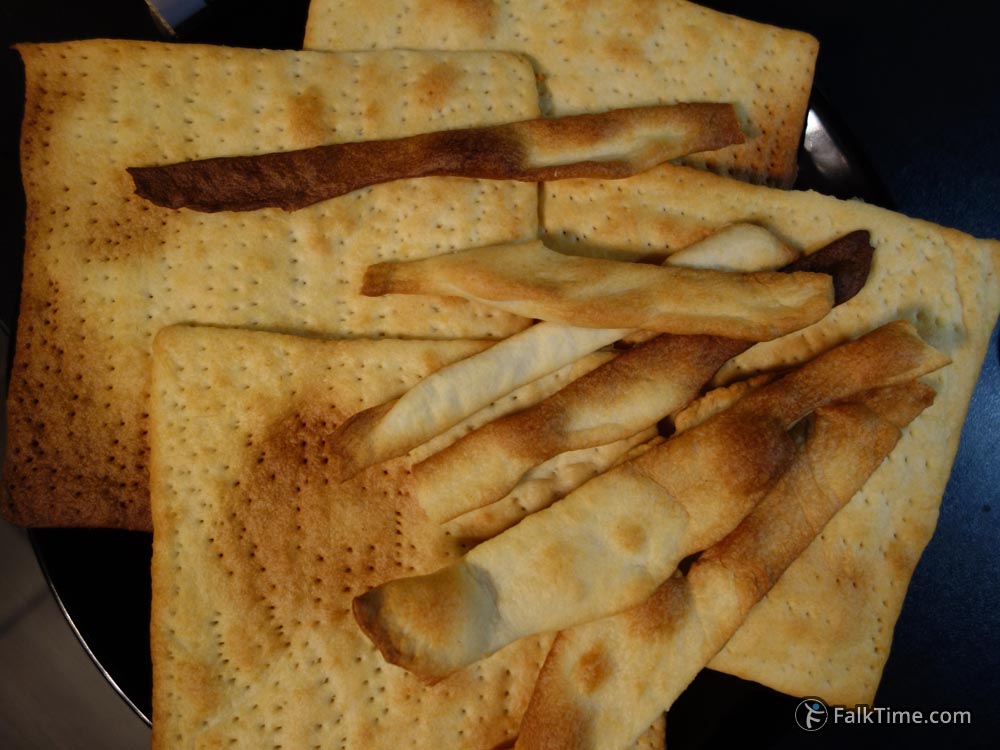
8. It’s easier to put all layers together in any mold (pot etc). Put a bag made of strong plastic to the bottom of pot (when you need to take the cake out, you just need to pull the plastic bag). Then put the first layer of dough (preferably whole one), spread some filling over it, then put the 2d layer of dough, etc. The last layer is filling.
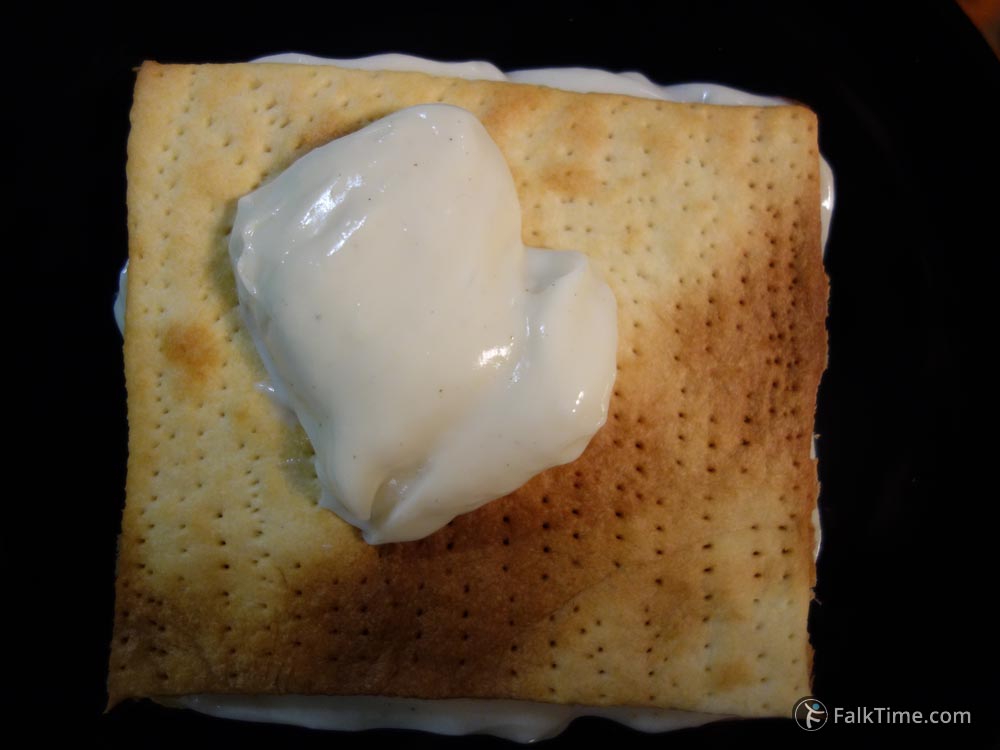
When you are ready with layers, turn offcuts into crumbles (I just break offcuts with fingers) and top the cake with crumbles. Before putting cake in a fridge make sure that it is well-packed (well-wrapped), so no smells (f.e. of nearby garlic) will reach it. Napoleon cake requires 1 day in a fridge.
If you want your cake to look neat and tidy, before serving: take it out of the mold pulling by plastic bag and cut off 1-2 cm. from each side. If your cake is round – you may turn it to a polygon.
If your Napoleon cake is long and wide, you’d rather cut it into pieces. If it is not, it can be easily transferred to a plate with long spatula (no matter how high it is).
Napoleon cake can be stored in a fridge for at least 5 days. But usually it disappears quicker as it happens to every tasty thing.

